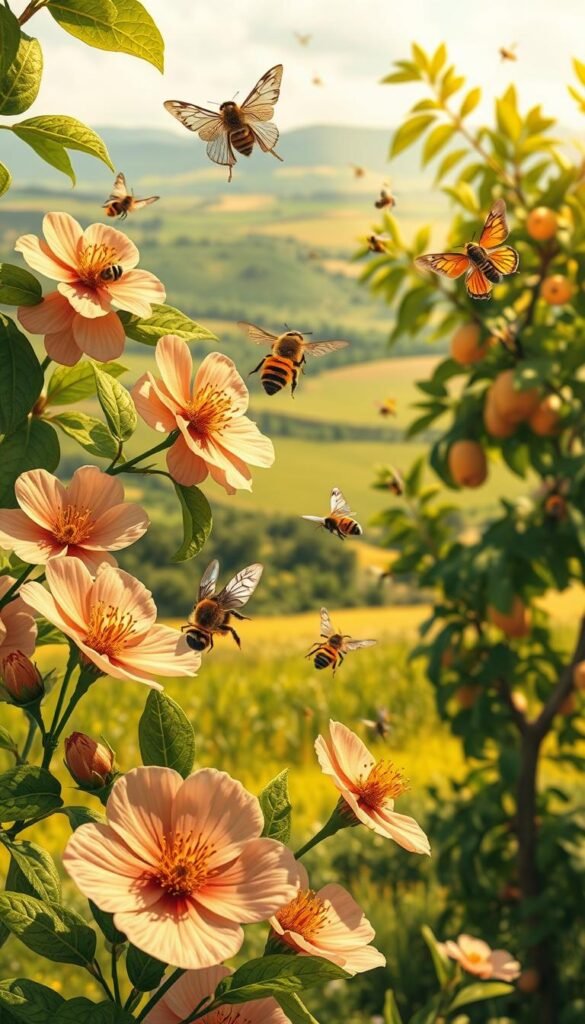Did you know your yard could produce juicy apples, crisp pears, and plump cherries with smart planning? While nature often handles pollination through local bee activity, strategic pairings can double your harvest size and quality. This resource breaks down the essentials without overwhelming you.
Many varieties thrive in diverse climates when given compatible partners nearby. Bees typically travel up to 500 feet, meaning neighboring yards might already provide what your trees need. But selecting specific cultivars ensures consistent results year after year.
You’ll find practical tips for matching bloom times and genetic groups across popular species. We’ve simplified complex botanical concepts into actionable steps – whether you’re planting two trees or twenty. Discover how slight adjustments in variety selection create dramatic improvements in yield.
Beyond classics like Honeycrisp apples and Bartlett pears, we’ll explore lesser-known options perfect for smaller spaces. Learn which combinations work best in your region while avoiding common pollination pitfalls. Let’s transform your outdoor space into a productive paradise!
Getting Started with Your Home Fruit Garden
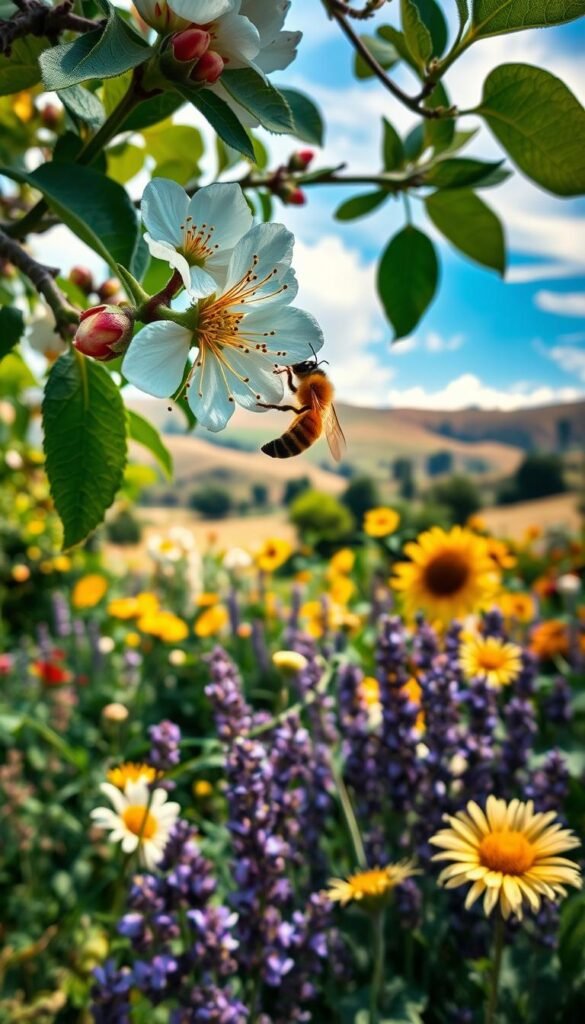
Imagine biting into a sun-warmed apple grown steps from your kitchen. To make this reality, you’ll need more than soil and sunshine – smart variety selection forms the backbone of every thriving orchard. Let’s explore two foundational concepts that separate sparse harvests from basket-busting yields.
Understanding the Basics of Fruit Cultivation
Most fruit trees demand pollen from a genetically distinct partner. A single Fuji apple tree might bloom beautifully, but without a nearby Granny Smith or Pink Lady, its flowers won’t transform into fruit. This biological handshake ensures genetic diversity while boosting crop resilience.
Bees typically shuttle pollen between trees within 200 feet. Urban gardeners often succeed by coordinating with neighbors – your crabapple might pollinate their Honeycrisp. Always verify bloom overlap: early-flowering varieties can’t pair with late bloomers, even if they’re technically compatible.
Why Your Orchard Needs a Pollination Plan
Strategic planting solves the “all flowers, no fruit” dilemma. Dwarf tree options let small spaces host multiple cultivars. A 10×10 area could hold two columnar apples and a patio peach, creating cross-pollination magic without sprawling roots.
Consider these essentials when designing your space:
- Overlap flowering periods by at least 4 days
- Mix self-sterile and partially self-fertile plants
- Include pollinator-friendly flowers like lavender
One Michigan grower increased her fruit production 300% simply by adding a second variety 15 feet from her lone pear tree. Your planning today determines tomorrow’s harvest!
Understanding Fruit Pollination Fundamentals
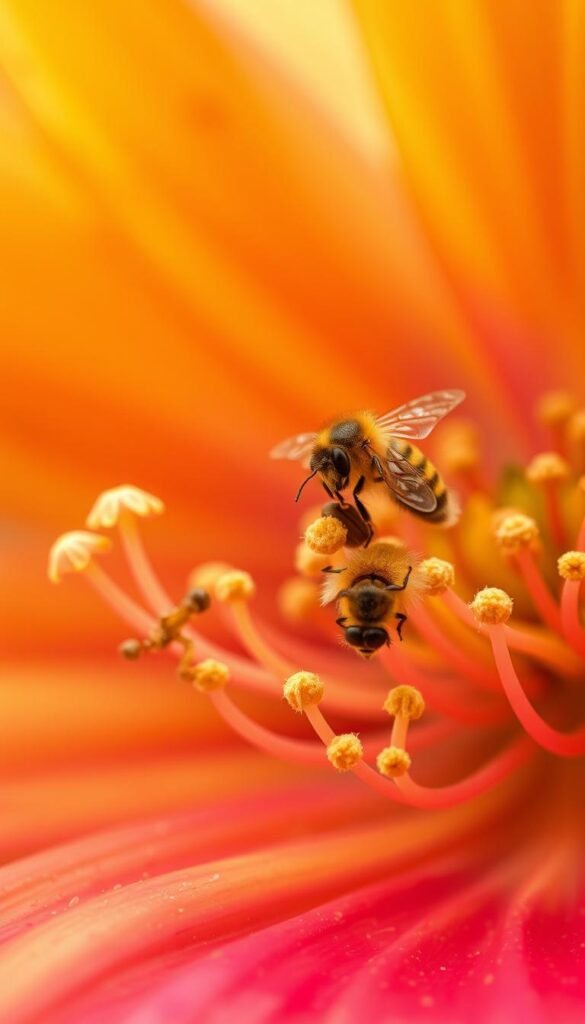
Think of pollination as nature’s matchmaking service – it’s where blossoms meet their perfect partners. While many plants can self-pollinate, most fruit trees thrive when pollen travels between different varieties. This natural teamwork creates tastier, more abundant crops through genetic diversity.
How Pollination Impacts Fruit Production
When bees carry pollen from one flower to another, they kickstart a transformation. Cross-pollinated trees often yield 20-30% more fruit compared to self-pollinated ones. The magic happens because mixing genetic material strengthens plants against pests and weather changes.
Look for these success signs:
- Flower petals falling within a week
- Swollen bases where blossoms once grew
- Small fruits forming 10-14 days after blooming
Key Pollinator Types: Bees, Birds, and More
Honeybees aren’t your only helpers. Bumblebees work earlier in cool mornings, while mason bees thrive in rainy weather. Hummingbirds transfer pollen as they sip nectar, and even beetles contribute by crawling through blossoms.
Diverse pollinators mean better coverage:
- Butterflies visit flat, open flowers
- Wasps prefer small clustered blooms
- Night-flying moths handle evening shifts
Planting native wildflowers near your trees creates a pollinator buffet. This simple step keeps your helpers well-fed and loyal to your garden’s needs.
Selecting the Right Pollination Partners for Apples and Pears
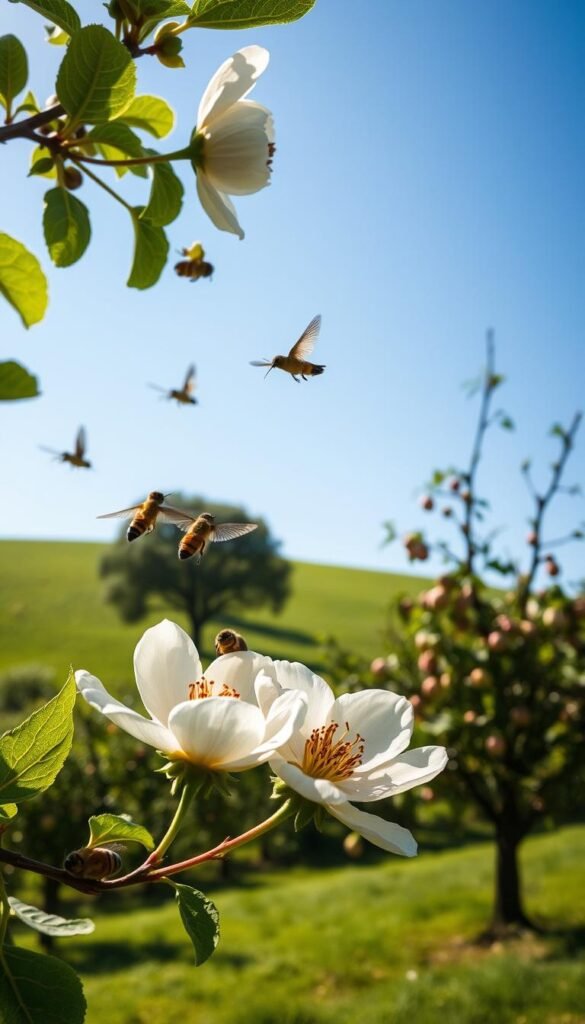
Picture this: two trees working together like best friends at a summer picnic. While apples and pears sometimes share pollen, their teamwork isn’t as rock-solid as pairing two different apple types or pear cultivars. Let’s explore how smart pairings unlock nature’s full potential in your backyard.
Cross-Pollination Essentials for Fruit Trees
Genetic diversity isn’t just science jargon – it’s your ticket to baskets overflowing with crisp snacks. Two identical apple trees like Honeycrisp clones can’t swap pollen effectively. You’ll need distinct varieties that bloom simultaneously, creating a pollen exchange window.
| Primary Tree | Best Partners | Avoid Pairing With |
|---|---|---|
| Gala Apple | Fuji, Granny Smith | Other Gala trees |
| Bartlett Pear | Bosc, Anjou | Same Bartlett clone |
| Pink Lady Apple | Crabapple, Braeburn | Sterile ornamentals |
Choosing Compatible Varieties for Better Yields
Ornamental crabapples often outshine regular pear trees as pollen powerhouses. Their long bloom periods cover multiple fruiting varieties. Just skip Spring Snow Crabapple – its pretty white flowers lack viable pollen.
Follow these pairing principles:
- Mix early and mid-season bloomers for extended pollination
- Include at least two apple varieties within 50 feet
- Check nursery tags for genetic compatibility notes
Urban gardeners often succeed by coordinating with neighbors. Your crabapple might pollinate their Fuji tree, creating a win-win harvest. Smart pairings turn random trees into a synchronized fruit factory!
Home Fruit Garden Guide: Pollination Partners for Apples, Pears, and More
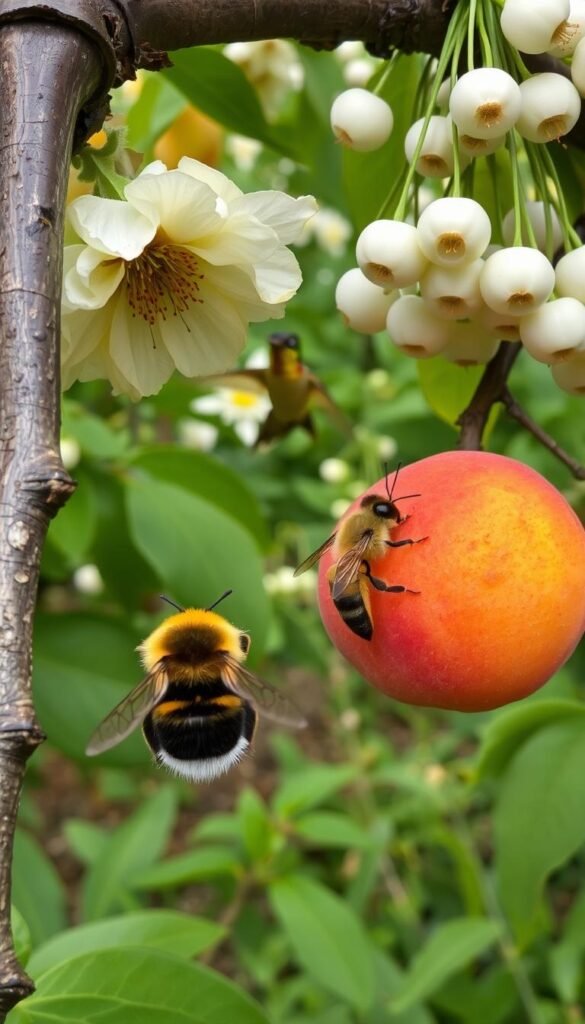
Ever wonder why some orchards overflow with ruby-red cherries while others struggle? Stone fruits demand precise partnerships. Unlike apples, most cherry and plum trees require specific genetic matches to bear fruit. Romeo cherries might sound independent, but pairing them with Juliet varieties triples their output.
| Category | Examples | Pollination Needs |
|---|---|---|
| Stone Fruits | Cherries, Plums | Require specific cross-pollinators |
| Self-Pollinators | Grapes, Blueberries | Produce solo but benefit from partners |
| Male/Female Plants | Kiwis, Sea Buckthorn | Need 1 male per 8 female plants |
Self-sufficient varieties simplify small gardens. Raspberries and strawberries work solo yet double their yield when neighbors share pollen. “My goji berries exploded after adding a second bush 10 feet away,” reports Oregon grower Marissa Tan.
Watch for these game-changers:
- Space-saving columnar cherries like Cupid
- Dwarf plum-apricot hybrids
- Cold-hardy saskatoons for northern zones
Kiwis demand careful planning – one male vine pollinates up to eight females. Sea buckthorn thrives in poor soil but needs same-species pairs. Mix self-reliant and partner-dependent plants to create a resilient, ever-bearing edible landscape.
Navigating Bloom Times and Chill Hours
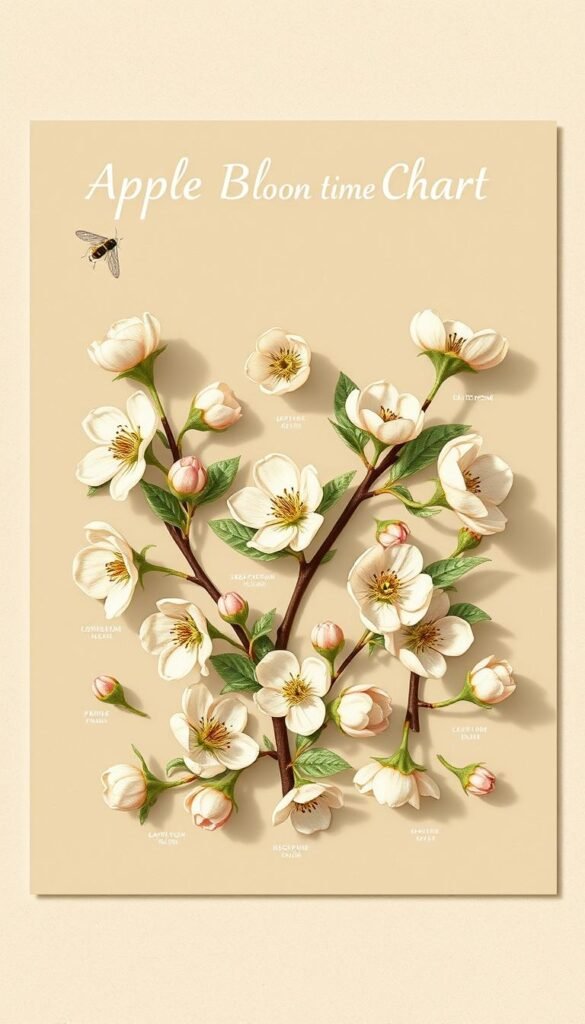
Timing is everything in nature’s pollination dance. Your trees’ success hinges on two critical factors: synchronized flowering periods and climate-adapted chill requirements. Let’s decode these elements to create a buzzing, productive orchard.
Matching Flowering Periods for Successful Pollination
Imagine two best friends arriving at a party hours apart – that’s what happens when apple varieties bloom at different times. Overlap is key: partners must share at least 4 days of open flowers. Early spring bloomers like Pink Lady pair best with mid-season types such as Fuji.
Watch your local weather patterns closely. A warm spell can accelerate flowering, while frost might delay it. One California grower boosted harvests by 40% after switching to varieties with matching bloom periods for her microclimate.
Understanding Chill Hour Requirements
Chill hours act as nature’s alarm clock. These cold time units (below 45°F) tell trees when to wake from dormancy. Mismatched requirements lead to chaotic flowering – like one tree blooming in February while its partner sleeps until April.
| Chill Category | Hours Needed | USDA Zones | Example Varieties |
|---|---|---|---|
| Low-Chill | 200-400 | 8-10 | Anna, Dorsett Golden |
| Moderate-Chill | 500-700 | 6-8 | Gala, Granny Smith |
| High-Chill | 800-1,000 | 4-6 | Northern Spy, Honeycrisp |
Coastal gardeners often choose low-chill types that handle mild winters. Mountain growers need cold-hardy varieties. “My Arkansas orchard thrived after I matched chill hours to my elevation,” shares orchardist Jake Whitmore.
Remember: bees won’t bridge a bloom time gap. Pair trees with similar chill needs and overlapping flowering schedules for nature’s perfect handshake.
Enhancing Your Garden’s Pollinator Habitat
Your backyard could become a buzzing hub of activity with simple habitat upgrades. Strategic companion planting turns ordinary spaces into thriving ecosystems where bees and other helpers flourish. Start by surrounding your trees with nectar-rich plants that bloom across seasons.
Attracting Beneficial Insects with Companion Plants
Diverse blooms act like neon signs for pollinators. Cluster native species like milkweed and coneflower near fruit-bearing areas – their flat petals make perfect landing pads. Mix in herbs like oregano, which offers both pollen and pest-repelling scents.
Follow these tips for year-round support:
- Plant early bloomers (crocus) and late-season stars (goldenrod)
- Include purple and yellow flowers – bee favorites
- Add shallow water sources with pebbles for safe sipping
Creating a Friendly Environment for Bees
Skip chemical sprays when blossoms appear. Try garlic-oil sprays for aphids instead. Leave some bare soil patches – 70% of native bees nest underground. A damp sand puddle with sea salt becomes a nutritious pit stop for butterflies.
Remember: every flowering shrub you add strengthens your garden’s natural workforce. With these changes, you’ll watch your harvests grow while supporting vital ecosystems!

